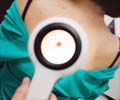The drug resistance process of melanoma has been discovered by UCLA's Jonsson Comprehensive Cancer Center researchers.

"Understanding and solving the problem of how cancer gets around targeted drugs is arguably one of the highest priorities in modern day cancer medicine. In this study, we found that in some patients, the cancer simply makes more of the target, the mutated BRAF gene, so that the drug dose becomes too weak to fight the cancer," said study senior author Dr. Roger Lo, an assistant professor of dermatology and molecular and medical pharmacology and a Jonsson Cancer Center scientist. "If you think of the mutation as a right hand and the BRAF inhibitor as a left hand and the two clasp to be effective, there's clearly an optimal radio to ensure the mutated gene is fully inhibited. Here, we get more of the drug target, which has the same effect as dropping the drug level."
The one-year study is published March 6, 2012, in the peer-reviewed journal Nature Communications.
About 50 percent of patients with metastatic melanoma, or 4,000 people a year, have the BRAF mutation and can be treated with Zelboraf, two pills taken twice a day. Zelboraf was approved by the U.S. Food and Drug Administration for use in metastatic melanoma in August of 2011. Many other common human cancers, including colon, thyroid and lung, also harbor BRAF-mutated subsets, Lo said.
Oncologists cannot give more Zelboraf to these patients to combat the increased number of mutated BRAF genes because the dose approved by the FDA is the maximum tolerated dose, Lo said. However, Zelboraf could perhaps be given with inhibitors of other cell signaling pathways in metastatic melanoma to try and stop patients from becoming resistant.
Lo and his team examined samples of 20 patients for this study, taking their normal tissue, their tumor tissue before treatment with Zelboraf and a sample when the cancer had responded earlier but subsequently became resistant. Using high-throughput DNA sequencing technology, the scientists examined the entire cancer exome to see what changes were occurring that may point to resistant mechanisms. Lo found that five of the 20 patients showed increased copies of the mutated BRAF gene. Cell lines developed from melanoma patients also showed pathways downstream of the amplified gene that could be blocked with inhibitors to fight resistance.
Advertisement
Lo said there's an experimental drug that also inhibits mutated BRAF which may be effective against this form of melanoma at a dose that does not result in substantial side effects. In that case, an oncologist might have room to increase the drug dose once a relapse driven by BRAF amplification is encountered in the clinic.
Advertisement
Going forward, Lo and his team will seek to find out what is happening molecularly in every patient that relapses after therapy, so novel combination drug strategies can be developed to help them. "If we know what happens in every relapse, we can have a plan in place that will help us avoid or overcome resistance," he said. About 70,000 new cases of melanoma are diagnosed each year in the United States. Of those, 8,000 people will die of the disease.
Source-Eurekalert













